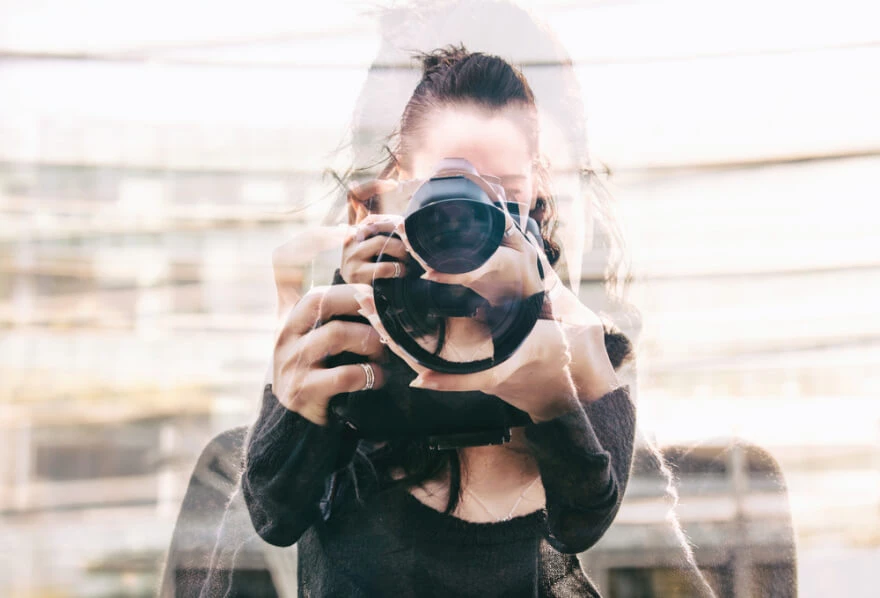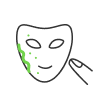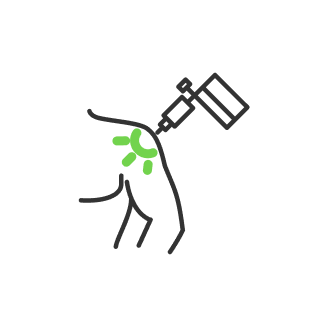TOP-11 Double Exposure Photography Ideas

- 1. Look for interesting themes to reflect
- 2. Get to know the camera options
- 4. Plan composition and portraits
- 5. Try silhouettes with both film and digital device
- 6. Discover cool double exposure art
- 7. Get more cool posters
- 8. Plan it all the way
- 9. Create double exposure portraits
- 10. Base silhouette-maker on nature
- 11. Try emotional and experimental themes
Usually a double exposure effect is used by photographers, using nothing else than a camera, which is able to combine two different photos. This technique is common for creating an abstract and surreal image, truly highly artistic photographs, with a complicated or an unusual idea. You can observe such pictures on album covers and even during some TV shows.
Keep in mind a short list of double exposure photography tips:
- One image should include a large object, the second one only small items.
- Always place dark frames under lighter areas.
- Mix different colors, including opposite.
- Capture the same story with several lenses.
- Image does not need to be colored, but shades of black and white should be aligned.
- Adjust yourself to lighting in excellent shooting locations
Many of us have ever looked out the window, watching the world outside, and at the same time noticed our own portrait reflection. Humans' eyes catch very original and interesting double images. Naturally, such an effect can be obtained not only with the help of design and graphic applications, but also with the help of a camera.

What is this creative effect used for?
- duplication of the subject, its reproduction in a frame
- creating motion effect, as well as motion-picture. For example, you can show movement of the moon, car or other object. The only drawback is the fact that each image can be translucent
1. Look for interesting themes to reflect

Practice with shooting in a classic mode, before launching the search for unusual. Probably, you asked yourself: “what is double exposure?” for the first time, when some of your images looked weird and seemed to be far from successful. Usually the first experience comes with window reflection. It does not have to be necessarily home or office, but can be also a shop window with products inside of it. Having seen a nice item, you must have made a snapshot, standing in front of it. As a result you may watch a transparent picture with blurred images and no contrasts, but an interesting idea.
2. Get to know the camera options

It is never too late to discover new features and options in your old camera. In fact if one is trying new modes of shooting, then a new approach in making pictures is needed. Many modern devices have such a function, for example. It will alert you with the corresponding indicator on the display or in the viewfinder. When specific shooting mode is complete, the resulting image will be only one shot.
The problem of some digital cameras is the fact that capture modes switch off automatically after a certain time. This disadvantage will not allow you to take a picture of one frame in the morning, and the second one in the evening, to create a stunning result. In this regard, film cameras will definitely help. You can cheat and take advantage of the image overlay function, but not all devices can offer it.
Surprisingly, not everyone knows that both film and digital devices can offer a wide range of settings to realize brave ideas. Start with simple objects and layers and read the manual well to become closer with your picture assistant. Do not ever forget to bring a tripod with you, planning a great photo album to make.
Decide on number of frames in double exposure photography

In general, at least two frames are required, that is why it is called “double”, sometimes “multi”. Maximum number is unlimited. But if one is using digital cameras, it is usually better to set a limited number. For various devices by famous brands, it is usually 3-10 frames. The number can become an advantage over android program method, since each picture will have to be added manually, and the shooting gadget can do everything by itself.
4. Plan composition and portraits

None is going to doubt your skills if you decide to use retouching programs to realize such an extraordinary picture. There are plenty of tools online to play with and create the amazing ghosting or blurred image, with double or even multi meaning. That is why no limits for your imagination and artistic taste are necessary for a great job. Easy tutorials and available software will make your picture album more extravagant.
You need to make several shots that need to be merged into one, and then with the help of layers and transparency, impose over others. Photo-editing gives flexibility to control overlay, accents and other parameters. Another advantage is the ability to use any number of snapshots preserving the original.
5. Try silhouettes with both film and digital device

Previously such a multi poster effect could occur due to a mistake, making two shots on the same piece of the film. To create artistic underlays or overlays on the main object in the frame. But undoubted artistry of some randomly obtained results led to the fact that this trend started its development and gained more and more popularity. Still, it is important to remember, If you don’t use the right settings, you can spoil a great shot! Play with aperture and choose the necessary mood, corresponding to the weather and light from “sunny” to “overcast”.To prevent overexposure, switch to the next lower aperture before shooting.
6. Discover cool double exposure art

It is used to enhance the depth of a surface and to make a picture indoors, where different light sources are used. Trying new modes and backgrounds, it is better to change light options depending on focusing. For moving portraits both black and white backdrops are successfully used by most experts. Every shot is unique with blending of frames and silhouettes. Interesting images can be obtained if you shoot studio portraits, both large-scale and full-growth, and then go to capture fields of flowers, landscapes or textures.
7. Get more cool posters

Mixing colors will allow you to get interesting results. Coming back to film cameras, black and white film can accept greater overexposure.You can also combine images made by different lenses: portrait and widescreen. A great option would be to combine street-photo with a cloudy sky or a sea surface. One may like abstraction of images and more practice will permit to create a unique unusual artistic work.
8. Plan it all the way

Every masterpiece is not just a simple click. Best results are obtained only with preparation in advance and detailed planning of the future image. Deep meaning of each shot is better displayed, when all significant elements are brought together. The combination of one image with another should seem natural and invite people to look at it again and again, discovering something new. Avoid matching two frames, overloaded with details, which will distract the view from a basic plot.
9. Create double exposure portraits

Another way to experiment is to clone an object (or yourself). Try to make your self portrait, using remote control for shots. Mount your device, select the number of frames you want to combine and repeat the process as many times as necessary. Depending on angles, lights and backdrops, you may find out that the picture is partially blurred. Ask friends or relatives to pose as well, trying to capture interesting motion moments.
10. Base silhouette-maker on nature

Choosing a classic option of silhouette picture with dual effects, do not neglect the nature palette. It is necessary to choose a clean background, without too much lights or darkness. The most successful examples are sky, sea, mountains or trees. Then the silhouette has to be placed in the frame, avoiding unnecessary details. This can be a person or any other object. The most important part is to have a specific plan. You can try positioning the image inside the silhouette.
11. Try emotional and experimental themes

If it is not easy to find a right object with necessary background, capture something you really care of. There is nothing so impressive and breathtaking, then combined pictures of people or objects, which wake up your emotions. Try this technique with black and white option and let viewers decide the depth of double exposure ideas.
Snapshots chosen for further combining can be different: made at different times, in various places. The key factor is that everything has to follow the plot and be well-planed.
All images have to be edited according to required size, but also color scale, degree of blur and background.

DON'T do list:
- Do not make the first frame in daylight, imposing a landscape on it with the daytime colors. This is the overexposure mistake. For example: You decided to take a close-up picture with a white wall.
- Do not make the first shot in a dark room or near dark objects. The second frame with a bright photo, completely interrupts the dark base, even if the object on the background is lightened or colored.
- Do not choose too many colors of the object and background. Shooting a watermelon on the background of a river is completely inappropriate. Opposite colors look much better.
- Do not overdo with textures. There are things that absolutely do not fit. Although such images sometimes turn out to be masterpieces, it is obvious that this is an exception, not a rule.

Every single shot is made with a specific reason and wish to demonstrate individual approach to common things around us. Changing tools and equipment we remain with our own thoughts and ideas. Artistic taste can become the only tip to considerate, when it comes to double exposure photos. That is why, sometimes most advice can be absolutely useless, because only personal experience will show essential points to pay attention to. Challenge yourself to discover new significant factors and have fun!
Co-founder of RetouchMe. In addition to business, he is passionate about travel photography and videography. His photos can be viewed on Instagram (over 1 million followers), and his films can be found on his YouTube channel.
Moreover, his profile is featured on the most popular and authoritative resource in the film industry — IMDb. He has received 51 international awards and 18 nominations at film festivals worldwide.

with RetouchMe














